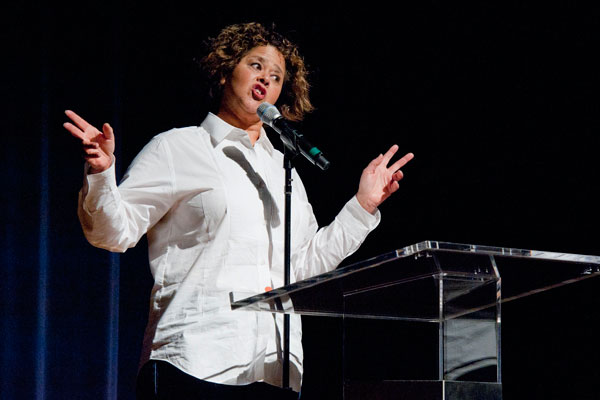
Last Friday concluded actress and performance-maker Anna Deavere Smith’s October residency at Stanford. Smith presented three of her works works: a screening of Twilight: Los Angeles 1992, and performances of Letter from a Birmingham Jail and The Pipeline Project. Co-presented by the Office of Religious Life, the Office of the Vice Provost of Undergraduate Education, and Stanford Live, the residency was an effort to spark dialogue, healing, and action during a turbulent time in America, as well as at Stanford.
The Pipeline Project, which premiered at Berkeley Rep over the summer, still falls into her quintessential performance style. A one-woman, multi-monologue performance, Smith portrays real people directly impacted by the school-to-prison pipeline trend. The dialogue of the performance, like all of her plays, comes from exact transcription of interviews with a variety of people—once-incarcerated juveniles, Stanford psychologists, protesters in Baltimore, court judges, Stockton city council members—in shaping a nuanced and multi-faceted portrayal of what the school-to-prison pipeline is and its implications beyond systems of education.
Based on my takeaways from the performance, the school-to-prison pipeline encompasses the notion that public school policies criminalize misbehavior. Within this increased criminalization, students of color and from low-income backgrounds are subjective disproportionately to exclusionary discipline or criminal prosecution. These students are stuck in a system that continues to criminalize them and not nurture, only to enter adulthood more likely to end up in jail—a sisyphean cycle, and the only way out appears to be a massive overhaul of the bureaucracy that shapes these systems.
The choice of creating performance out of interviews brings an important explanation of such a complex concept. The school-to-prison pipeline trend dehumanizes people—students are treated as objects that go in and out of the system, education seems to be about getting in and out, and not being nurtured, interactions seem to be based on order and efficiency, and not personhood. Though Anna Deavere Smith’s metamorphosing into a variety of characters, we began to see the individuals within these systems. We saw the individual humanity within the system because we saw Anna become a Yurok student who had spent time in juvenile hall, and then, a Philadelphia judge who felt that the system had failed a kid when he spent time in and out of juvenile hall. We developed what many of the professors and policy researchers that Anna portrayed what could change this trend: empathy.
The purposeful forgoing of production values, the only set being a variety of chairs, and the only costume being the occasional jacket or shoe change, allowed us, the audience, to engage with our empathy. Anna’s ability to activate dialogue and differentiate between such a diversity of characters, without appearing to be over the top or too performative made that empathy believable. And bassist Marcus Shelby’s stylings and transitions allowed us that extra visceral dimension to our empathy.
On the path to creating change, . Anna Deavere Smith’s earlier works, such Twilight: Los Angeles, seek to garner empathy in order to heal and process trauma. In Twilight: Los Angeles, there are more unanswered questions and murky areas surrounding the morality and racial relations of the violence that occurred after the Rodney King verdict in 1992. However, the urgency of current event propelled The Pipeline Project—change needs to happen, this is an irrefutable problem. Adding to the urgency were video recordings of police violence inflicted upon Freddie Gray and at a pool party in McKinney, Texas. Anna Deavere Smith connects the unfairness of the education system with the epidemic of violence inflicted upon bodies of color.
How does a theatrical piece, in which the audience sits passive, spark institutional change? Indeed, what was performed at the Bing Concert Hall was only the first act of the piece that premiered at Berkeley Rep. Act II is discussion, brainstorming for change, what can be done now. The performance I saw could have benefited from a breakout session, a mixing of ideas from Stanford undergrads, and Stanford Live’s subscribers, creating more specific solutions to the very vast and complex problem Anna explored in her performance.
Anna may not have given us the answers, but the visceral medium of her performance shook us in a way that drives us to fight for a solution.
* * *
Organizations and Resources (as referenced by the show’s program notes):
Alliance for Education Justice is a national collective of advocacy groups that work with policymakers to transform public education into a system that prepares all students—regardless of race or socioeconomic status—for college, meaningful employment, and full participation in democracy.
Campaign for Youth Justice is a national initiative focused entirely on ending the prosecution and incarceration of youth under the age of 18 in the adult criminal justice system.
Youth United for Community Action provides a safe space in East Palo Alto where young people of color can organize to address environmental and social justice issues.
East Palo Alto Youth Court is a peer court alternative to juvenile courts that partners with schools using restorative justice to address infractions while keeping students in school.
Fresh Lifelines for Youth (FLY) is a nonprofit founded by Stanford Law School alumna Christa Gannon that is dedicated to breaking the cycle of violence, crime, and incarceration of teens. Through FLY’s combination of programs—legal education, leadership training, and one-on-one mentoring—youth get off probation, engaged in school, and back on track with their lives. Learn more and sign up to volunteer at flyprogram.org
Photo courtesy of here.
